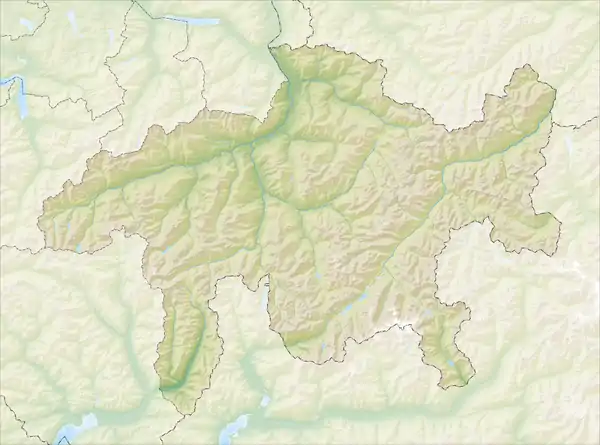Verdabbio | |
|---|---|
 | |
 Coat of arms | |
Location of Verdabbio | |
 Verdabbio  Verdabbio | |
| Coordinates: 46°16′N 9°09′E / 46.267°N 9.150°E | |
| Country | Switzerland |
| Canton | Graubünden |
| District | Moesa |
| Government | |
| • Mayor | Antonio Spadini |
| Area | |
| • Total | 13.13 km2 (5.07 sq mi) |
| Elevation | 604 m (1,982 ft) |
| Population (Dec 2015) | |
| • Total | 163 |
| • Density | 12/km2 (32/sq mi) |
| Time zone | UTC+01:00 (Central European Time) |
| • Summer (DST) | UTC+02:00 (Central European Summer Time) |
| Postal code(s) | 6538 |
| SFOS number | 3836 |
| Surrounded by | Cama, Castaneda, Cauco, Gordona (IT-SO), Grono, Leggia, Lostallo, Santa Maria in Calanca |
| Website | www SFSO statistics |
Verdabbio is a former municipality in the district of Moesa in the Swiss canton of Graubünden. On 1 January 2017 the former municipalities of Leggia and Verdabbio merged into the municipality of Grono.[2]
History
Verdabbio is first mentioned in 1203 as Vertabio.[3]
Geography
Verdabbio had an area, as of 2006, of 13.1 km2 (5.1 sq mi). Of this area, 4.9% is used for agricultural purposes, while 62.1% is forested. Of the rest of the land, 1.1% is settled (buildings or roads) and the remainder (31.9%) is non-productive (rivers, glaciers or mountains).[4]
The former municipality is located in the Roveredo sub-district of the Moesa district.
Demographics
Verdabbio had a population (as of 2015) of 163. As of 2008, 11.8% of the population was made up of foreign nationals.[5] Over the last 10 years the population has decreased at a rate of -1.9%. Most of the population (as of 2000) speaks Italian (85.4%), with German being second most common (14.0%).[4]
As of 2000, the gender distribution of the population was 47.2% male and 52.8% female.[6] The age distribution, as of 2000, in Verdabbio is; 18 children or 11.0% of the population are between 0 and 9 years old. 8 teenagers or 4.9% are 10 to 14, and 10 teenagers or 6.1% are 15 to 19. Of the adult population, 13 people or 7.9% of the population are between 20 and 29 years old. 35 people or 21.3% are 30 to 39, 17 people or 10.4% are 40 to 49, and 33 people or 20.1% are 50 to 59. The senior population distribution is 11 people or 6.7% of the population are between 60 and 69 years old, 11 people or 6.7% are 70 to 79, there are 7 people or 4.3% who are 80 to 89, and there is 1 person who is 90 to 99.[5]
In the 2007 federal election the most popular party was the SP which received 47% of the vote. The next three most popular parties were the CVP (24.4%), the SVP (18.5%) and the FDP (10.1%).[4]
In Verdabbio about 59.8% of the population (between age 25-64) have completed either non-mandatory upper secondary education or additional higher education (either university or a Fachhochschule).[4]
Verdabbio has an unemployment rate of 2.68%. As of 2005, there were 8 people employed in the primary economic sector and about 3 businesses involved in this sector. 2 people are employed in the secondary sector and there are 2 businesses in this sector. 11 people are employed in the tertiary sector, with 7 businesses in this sector.[4]
The historical population is given in the following table:[3][6]
| year | population |
|---|---|
| 1850 | 198 |
| 1900 | 185 |
| 1950 | 177 |
| 1960 | 154 |
| 1970 | 159 |
| 1980 | 156 |
| 1990 | 143 |
| 2000 | 164 |
References
- ↑ "Arealstatistik Standard - Gemeinden nach 4 Hauptbereichen". Federal Statistical Office. Retrieved 13 January 2019.
- ↑ Amtliches Gemeindeverzeichnis der Schweiz published by the Swiss Federal Statistical Office (in German) accessed 27 April 2016
- 1 2 Verdabbio in German, French and Italian in the online Historical Dictionary of Switzerland.
- 1 2 3 4 5 Swiss Federal Statistical Office accessed 23-Oct-2009
- 1 2 Graubunden Population Statistics Archived August 27, 2009, at the Wayback Machine (in German) accessed 21 September 2009
- 1 2 Graubunden in Numbers Archived September 24, 2009, at the Wayback Machine (in German) accessed 21 September 2009
External links
- Official website (in Italian)
- Verdabbio in German, French and Italian in the online Historical Dictionary of Switzerland.